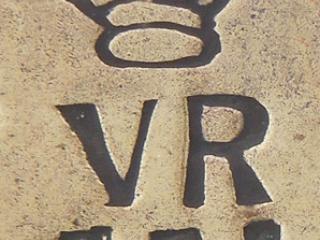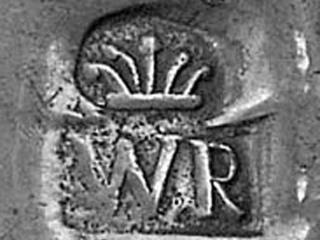Verification and capacity marks

These marks only appear on drinking vessels and measures that are made to a specific capacity.
Capacity marks
A capacity mark such as ‘pint’ or ‘quart’ is self explanatory. Such marks became a legal requirement in 1836. The presence of such a mark does not mean the item is post-1836 as vessels made before then which remained in use after 1836 were often marked retrospectively. Equally, the absence of any capacity mark does not mean the vessel must be pre-1836 as not everyone adhered to the law.
Verification marks
A verification mark signifies that the measure has been inspected by an official Weights & Measures Inspector and found to be of the correct capacity. It became a country-wide legal requirement to stamp all measures with a verification mark in 1835, though some areas such as the Cities of London and Westminster had being do so before this. Until about 1878 each town generally had its own style of mark. From roughly 1879 onwards a uniform style was adopted consisting of a crown, the monarch’s initials (ie VR, ER or GR) and a number which signifies the location. Measures were often inspected several times during their lifetime and thus can carry several verification marks. Sometimes at subsequent inspections the inspector merely stamped a two digit number signifying the year of re-inspection.
For more information on verification marks, see:
Marks and Markings of Weights and Measures of the British Isles by Carl Ricketts and John Douglas 1996, ISBN 0 952 853 302.
Downloadable below
Marks denoting the capacity standard
In 1826 the Imperial Standard was introduced to supersede a number of other standards that had been in use until then. In practice a number of regions failed to switch to the new standard until several years later, and indeed non-Imperial standards were still occasionally being used in the late 19th century. The word Imperial on a measure shows it was made to the new standard and is therefore post-1826.
Prior to the compulsory introduction of verification marks in 1835, pewterers often punched their own mark to indicate the capacity standard to which the measure conformed. These take the form of a crown over the monarch’s initials. The most common ones are:
- Crowned WR: made to the pre-Imperial William III ale standard.
- Crowned GIVR: made to the George IV standard of 1826, ie Imperial Measure. This mark probably continued in use until amending Acts came into force in 1835 and 1836.
- Crowned WIVR: made following the amending Acts of 1835 and 1836. This mark continued in use until at least 1855.
-
Very occasionally, a crowned AR or a crowned HR will be found on earlier measures.

